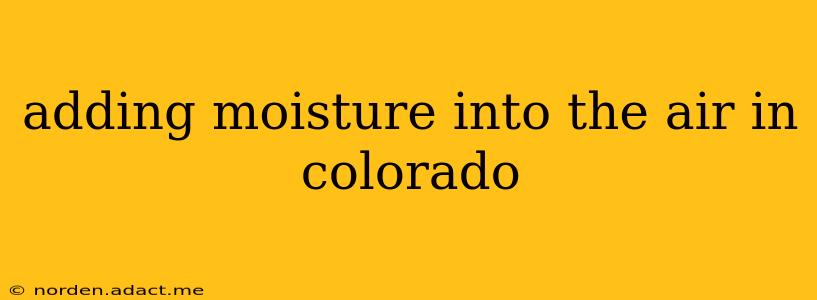Colorado's famously dry climate, while offering stunning vistas and sunshine, presents a unique challenge: low humidity. This dryness can lead to a range of issues, from dry skin and irritated sinuses to damaged wood furniture and static electricity. Fortunately, there are several effective ways to add moisture to the air in your Colorado home or office. This comprehensive guide explores various humidification methods, addressing common concerns and helping you choose the best solution for your needs.
Why is Humidity Important in Colorado?
Colorado's arid climate boasts low humidity levels, often below 30%, especially during the winter months. This low humidity can have several negative consequences:
- Health Issues: Dry air can irritate the respiratory system, leading to dry coughs, nosebleeds, and worsening of conditions like asthma and allergies. Dry skin and chapped lips are also common complaints.
- Home Damage: Low humidity can cause wood furniture to crack and shrink, damaging floors and other wooden elements in your home. It can also exacerbate static electricity, leading to shocks and damage to electronics.
- Discomfort: Dry air can feel uncomfortable, leaving you feeling parched and potentially impacting your sleep quality.
What are the Different Ways to Add Moisture to the Air in Colorado?
Several methods exist for increasing humidity levels in your Colorado home. Let's explore the most popular options:
1. Humidifiers:
Humidifiers are the most direct and effective way to add moisture to the air. Several types are available:
- Evaporative Humidifiers: These are relatively inexpensive and energy-efficient, adding moisture through evaporation. They require regular cleaning to prevent mold and mineral buildup.
- Ultrasonic Humidifiers: These use high-frequency vibrations to create a fine mist, making them quieter than evaporative models. However, they can also produce white dust if not properly maintained.
- Steam Vaporizers: These boil water to create steam, offering the most effective humidification but consuming more energy.
Choosing the Right Humidifier: Consider the size of the room, your budget, and your maintenance preferences when selecting a humidifier.
2. Houseplants:
While not as effective as humidifiers, houseplants can contribute to increased humidity levels. Plants naturally release moisture through transpiration, adding a small amount of humidity to the surrounding air. Grouping several plants together can enhance their effect.
3. Boiling Water:
A simple and temporary solution involves boiling a pot of water on the stove. The steam released will add moisture to the air, though this is not a sustainable long-term solution.
4. Wet Towels or Clothes:
Hanging damp towels or clothes on a clothesline or radiator can also slightly increase humidity. However, this method is less effective than humidifiers and can be aesthetically unappealing.
5. Using a Shower:
Taking a hot shower or bath adds moisture to the air in the bathroom. Leaving the bathroom door open can help distribute this moisture to adjacent rooms.
How Much Humidity is Ideal for Colorado Homes?
The ideal humidity level for most Colorado homes is between 30% and 50%. Using a hygrometer (a device that measures humidity) allows you to monitor the humidity levels in your home and adjust your humidification methods accordingly. Excessively high humidity can also create problems, such as mold growth.
What are the potential problems with using a humidifier?
While humidifiers are highly effective, they require regular maintenance to prevent problems:
- Mold and Mildew: Humidifiers can harbor mold and mildew if not cleaned regularly. Follow the manufacturer's instructions for cleaning and disinfecting your humidifier.
- Mineral Buildup: Hard water can leave mineral deposits in your humidifier, reducing its efficiency and potentially damaging it. Use distilled water or a water filter to mitigate this issue.
- Increased Allergens: Humidifiers can increase the concentration of allergens in the air if not properly cleaned and maintained.
How Often Should I Clean My Humidifier?
The frequency of cleaning your humidifier depends on the type and the water hardness in your area, but it should be cleaned at least once a week, ideally more frequently. Always consult your humidifier's manual for specific cleaning instructions.
This guide provides a comprehensive overview of methods for adding moisture to the air in Colorado. By understanding the benefits and drawbacks of each approach, you can make an informed decision to create a more comfortable and healthy living environment. Remember, consistent monitoring of humidity levels using a hygrometer is key to maintaining optimal conditions within your home.
